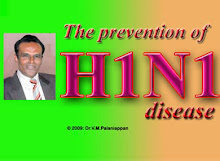As of 16 May, worldwide more than 214 countries and overseas territories or communities have reported laboratory confirmed cases of pandemic influenza H1N1 2009, including over 18097 deaths, WHO said Friday.
The current situation is largely unchanged since the last update. The most active areas of pandemic influenza virus transmission currently are in parts of the Caribbean and Southeast Asia. In the temperate zone of the northern and southern hemisphere, overall pandemic influenza activity remains low to sporadic. In central Africa, there has been increased transmission of seasonal influenza type B viruses, accounting for 85% of all influenza isolates in the region. Influenza B also continues to be detected at low levels across parts of Asia and Europe, and has now been reported in Central America.
In the tropical region of the Americas, the most active areas of pandemic influenza virus transmission continue to be in parts of the Caribbean. In Cuba, a second period of active community transmission of pandemic influenza virus began during late February 2010, peaked during late April 2010, and has been declining since; this second period of transmission, although associated with severe and fatal cases, appears to be less intense overall than the first period of transmission which occurred during late September to late November 2009. In contrast, in the Dominican Republic, low to moderate intensity of respiratory diseases activity has been primarily associated with co-circulation of respiratory viruses other than influenza; only sporadic detections of seasonal influenza viruses have been reported.
Low levels of pandemic influenza viruses have been circulating across parts of Central America and tropical areas of South America, for example, in Mexico since December 2009, in Colombia and Brazil since early 2010, and in Guatemala since early April 2010. Nicaragua and Honduras have also been recently reporting geographically regional spread of influenza viruses, however, the relative proportions of seasonal influenza, pandemic influenza, and other respiratory virus detections are not known. In contrast, in Panama, low levels of respiratory disease over the past three months have been primarily associated with circulating respiratory viruses other than influenza. Of note, Bolivia experienced a recent period of low but sustained transmission of seasonal influenza type B viruses between late February and early May 2010. There continues to be evidence from several countries in this region that there is ongoing co-circulation of influenza with other respiratory viruses (including respiratory syncytial virus (RSV), and adenovirus).
In Asia, the most active areas of pandemic influenza virus transmission are in parts of South and Southeast Asia, particularly in Bangladesh, Malaysia, and Singapore. In Malaysia, limited data suggests that a second period of active pandemic influenza virus transmission has been occurring since early April 2010, but overall activity may have recently stabilized and does not appear to exceed pandemic influenza activity seen during an earlier period of transmission lasting from July until early September 2009. In Singapore, levels of ARI have remained elevated since mid April 2010; during the most recent reporting week, levels of ARI exceeded the epidemic threshold and the proportion of patients with ILI testing positive for pandemic influenza virus infection was 39%. In Bangladesh increased co-circulation of pandemic influenza and seasonal influenza type B viruses has been detected since mid April 2010 but now appears to have stabilized. Low level circulation of pandemic influenza continues to persist in Thailand and in the western and southern parts of India; sporadic detection of pandemic influenza continue to be reported in Cambodia and in the Philippines. In East Asia, only sporadic detections of pandemic influenza virus are being reported; seasonal influenza type B viruses have been predominant in this region, however circulation appears to be declining in China and the Republic of Korea.
In the temperate regions of the northern and southern hemisphere, overall pandemic influenza activity remains low to sporadic. In Australia and New Zealand, slight increases in ILI activity were reported; however, in Australia, these increases have been attributed primarily to circulating respiratory viruses other than influenza. In the southern temperate regions of the Americas, only sporadic detections of influenza viruses have been reported, except in Chile, which continues to report localized areas of increased ILI activity (in the Los Lagos area) associated with co-circulation of pandemic influenza and other respiratory viruses. In Europe, very low to sporadic levels of pandemic and seasonal influenza type B viruses continue to be detected. Seasonal influenza type B virus persists mainly in parts of eastern and northern Europe. Georgia reported an increase in the number of respiratory disease consultations due to influenza-like-illness (ILI), mainly in children (under age 5) and school-age children (5-14 years old age group); whether this increase is associated with pandemic influenza A (H1N1) virus is not yet known.
The current situation is largely unchanged since the last update. The most active areas of pandemic influenza virus transmission currently are in parts of the Caribbean and Southeast Asia. In the temperate zone of the northern and southern hemisphere, overall pandemic influenza activity remains low to sporadic. In central Africa, there has been increased transmission of seasonal influenza type B viruses, accounting for 85% of all influenza isolates in the region. Influenza B also continues to be detected at low levels across parts of Asia and Europe, and has now been reported in Central America.
In the tropical region of the Americas, the most active areas of pandemic influenza virus transmission continue to be in parts of the Caribbean. In Cuba, a second period of active community transmission of pandemic influenza virus began during late February 2010, peaked during late April 2010, and has been declining since; this second period of transmission, although associated with severe and fatal cases, appears to be less intense overall than the first period of transmission which occurred during late September to late November 2009. In contrast, in the Dominican Republic, low to moderate intensity of respiratory diseases activity has been primarily associated with co-circulation of respiratory viruses other than influenza; only sporadic detections of seasonal influenza viruses have been reported.
Low levels of pandemic influenza viruses have been circulating across parts of Central America and tropical areas of South America, for example, in Mexico since December 2009, in Colombia and Brazil since early 2010, and in Guatemala since early April 2010. Nicaragua and Honduras have also been recently reporting geographically regional spread of influenza viruses, however, the relative proportions of seasonal influenza, pandemic influenza, and other respiratory virus detections are not known. In contrast, in Panama, low levels of respiratory disease over the past three months have been primarily associated with circulating respiratory viruses other than influenza. Of note, Bolivia experienced a recent period of low but sustained transmission of seasonal influenza type B viruses between late February and early May 2010. There continues to be evidence from several countries in this region that there is ongoing co-circulation of influenza with other respiratory viruses (including respiratory syncytial virus (RSV), and adenovirus).
In Asia, the most active areas of pandemic influenza virus transmission are in parts of South and Southeast Asia, particularly in Bangladesh, Malaysia, and Singapore. In Malaysia, limited data suggests that a second period of active pandemic influenza virus transmission has been occurring since early April 2010, but overall activity may have recently stabilized and does not appear to exceed pandemic influenza activity seen during an earlier period of transmission lasting from July until early September 2009. In Singapore, levels of ARI have remained elevated since mid April 2010; during the most recent reporting week, levels of ARI exceeded the epidemic threshold and the proportion of patients with ILI testing positive for pandemic influenza virus infection was 39%. In Bangladesh increased co-circulation of pandemic influenza and seasonal influenza type B viruses has been detected since mid April 2010 but now appears to have stabilized. Low level circulation of pandemic influenza continues to persist in Thailand and in the western and southern parts of India; sporadic detection of pandemic influenza continue to be reported in Cambodia and in the Philippines. In East Asia, only sporadic detections of pandemic influenza virus are being reported; seasonal influenza type B viruses have been predominant in this region, however circulation appears to be declining in China and the Republic of Korea.
In the temperate regions of the northern and southern hemisphere, overall pandemic influenza activity remains low to sporadic. In Australia and New Zealand, slight increases in ILI activity were reported; however, in Australia, these increases have been attributed primarily to circulating respiratory viruses other than influenza. In the southern temperate regions of the Americas, only sporadic detections of influenza viruses have been reported, except in Chile, which continues to report localized areas of increased ILI activity (in the Los Lagos area) associated with co-circulation of pandemic influenza and other respiratory viruses. In Europe, very low to sporadic levels of pandemic and seasonal influenza type B viruses continue to be detected. Seasonal influenza type B virus persists mainly in parts of eastern and northern Europe. Georgia reported an increase in the number of respiratory disease consultations due to influenza-like-illness (ILI), mainly in children (under age 5) and school-age children (5-14 years old age group); whether this increase is associated with pandemic influenza A (H1N1) virus is not yet known.
source







